Let me begin by apologizing in advance to anyone who over the past many years has gotten me one or more of the gifts on this list. It is not your fault. No one told you. In fact, if your affection for me led you to scour the wine, museum, fine art or Spenser Gifts catalogs you were likely bombarded with these absolutely horrible suggestions of gifts “for the wine lover in your life.”
Many of these items are described as “artistic” or “decorative.” My objections to these items are not based solely on aesthetics, although, yes, I find many of the designs truly awful. The greater issue is that these items are trading on their decorative stylings at the expense of functionality, or they serve no function at all. And that is an objection that would be most clearly understood by all of the wine geeks in your lives.
Think about it. You probably would never think to give a walrus tusk wine cork puller to someone you did not think of as a wine lover. But the people who are investing in quality wines are probably also investing in the tools they need. These items are marketed for the absolute wrong people on your holiday gift list.
Decorative Wine Bottle Stoppers
There are, literally, as many different wine bottle stoppers as there are pieces of construction debris and broken toys in the world. From the quaint to the bizarre to the obscene, someone has bolted it on top of an inverted chrome cone with rubberized o-rings on it or glued to a tapered cork and sold it by the thousands to people who picked my name in the Secret Santa!
While these five items are not presented in any order, it is true that the wine bottle stopper is probably the one I have received the most. I have one that looks like a big square door knob with a big “W” on it. I have holiday bottle stoppers and patriotic bottle stoppers and bottle stoppers in support of several different sports franchises. What I do not have is a need for a bottle stopper.
Virtually every serious wine person I have ever heard talk about bottle stoppers says the same thing: “There is never any wine left in the bottle.” I realize that is not always the case, but much of the time it is.
When there is some wine left in the bottle, many of us have a can of inert gas like argon or nitrogen that we spray into the bottle. These gases are heavier than air and settle on the surface of the remaining wine, protecting it from the oxygen. Then we put the cork back in the bottle and pop it in the refrigerator. Or we cork it without the gas and pop it in the refrigerator. Some people use little vacuum pumps that claim to remove the air from the bottle. The pumps come with their own bottle closures intended to maintain the vacuum.
None of these solutions are perfect. Some sources argue that nitrogen gas interacts negatively with the wine. Others argue that the vacuum pumps not only fail to create a sufficient vacuum to protect the wine but that the vacuum condition itself extracts flavor compounds from the remaining wine.
But there is a fairly broad consensus that at cooler temperatures chemical reactions are slowed, so refrigerating the partially-used wine will help preserve it. Some of the more elaborate stoppers would make it more difficult to fit the bottle into the refrigerator, and in any case, what is the purpose of a decorative stopper if the wine is just going into the refrigerator where no one will see it anyway? My answer is – none.
Artistic Countertop Wine Bottle Holders and Racks
The first time I received one of these as a gift, I honestly did not know what it was. It was a curved and painted piece of wood, about three inches wide and ten inches long, with a hole about an inch and a half in diameter on one end. I later discovered that this was a wine bottle holder. I was supposed to take a bottle of wine and put the cork end through the hole with the bottle suspended over the curved piece of wood. With a little tinkering, I could get the bottle to balance on the curve, and I could store one bottle of wine on my countertop so people could see it.
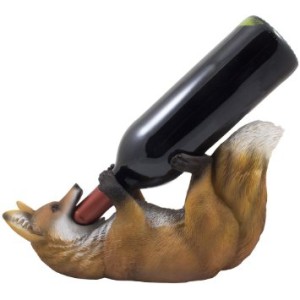 I understand that not everyone has ideal wine storage and having a small rack that holds maybe a dozen bottles can be a good solution for the casual wine drinker. I will therefore concede that at the larger end of the countertop wine rack spectrum, there can be some utility. But that is much less the case for a serious wine lover, and is certainly not the case at the smaller (and often more kitschy or artistic) end of the spectrum.
I understand that not everyone has ideal wine storage and having a small rack that holds maybe a dozen bottles can be a good solution for the casual wine drinker. I will therefore concede that at the larger end of the countertop wine rack spectrum, there can be some utility. But that is much less the case for a serious wine lover, and is certainly not the case at the smaller (and often more kitschy or artistic) end of the spectrum.
First, nothing that provides a storage solution for only one, two or three bottles of wine has any utility whatsoever to a more serious wine lover. I assume that the idea behind the racks is that I have some bottle of wine that I really want people to see, but the wines that I most treasure will not benefit by being stored on the kitchen table.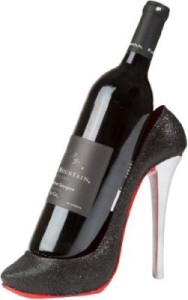
All wine, red, white and rosé, benefits from cool, dark storage with minimal vibration. That does not describe the kitchen table, mantle or top of the refrigerator in anyone’s home. Besides, if I am truly so enamored of a wine that I want people to see it, why would I display it jutting out of part of a ski, being suckled by a clay animal or sitting in a women’s stiletto? Again it is an easy answer; I would not.
Wine Charms
The wine charm strikes me as yet another product invented prior to identification of a need. The idea is based on the notion that all wine glasses look pretty much alike. At a gathering people drinking wine will often set down their glasses and then forget which glass is theirs.
The wine charm is a small wire fashioned into a circle and decorated with colored beads or, perhaps, any of the pieces of broken toys that did not make it into a wine stopper. The charm is fastened around the stem of the wine glass, and at the party, the person who would normally forget which glass is theirs can then identify their glass by the red beads (vs. the green, yellow or blue beads), the Yoda head or the cute word on the wine charm. With the rise of the stemless wine glass, I have started to see two-piece wine charms with a magnet on the inside of the glass that will hold the red shoe or the yellow bead on the outside of the glass.
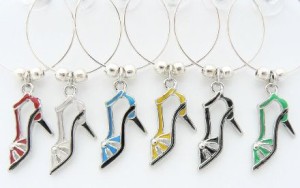 From the host’s perspective, as someone who has hosted many parties and served a lot of wine, the wine charm is a real pain in the glass. As if the host did not have enough responsibility in the run up to and during a good party, putting the wine charms on the glasses and taking them off again so the glasses (and the wine charms!) can be cleaned at the end of the evening are simply additional tasks with zero pay off.
From the host’s perspective, as someone who has hosted many parties and served a lot of wine, the wine charm is a real pain in the glass. As if the host did not have enough responsibility in the run up to and during a good party, putting the wine charms on the glasses and taking them off again so the glasses (and the wine charms!) can be cleaned at the end of the evening are simply additional tasks with zero pay off.
Moreover, wine charms are most often marketed in packets of four–four colors of beads, four wine-related words, four superhero heads, etc. If there are only four people at a party, I would not think that the mis-identified wine glass is that much of an issue. And if it is, if your guest cannot remember that he or she set down his or her glass on the table next to the sofa, it is unlikely they will remember that theirs was the glass with the red-beaded wine charm, and not the yellow or the blue.
If you are hosting a larger party, then you would need a larger collection of wine charms, and you really cannot just buy six packets of the same charms. How would your rocket-scientist guests know which of the red-beaded-charm-adorned glasses was theirs. There would be so many of them at the party!
Finally, someone might say that the wine charm is meant simply as an adornment, bringing an aesthetic or whimsical note to a party. First, a beautiful piece of stemware from Riedel or Spiegelau or one of the other, even more expensive, manufacturers is not lacking in aesthetics and does not require the adornment of a tacky ringlet. The wine geeks in your life find the glass and the wine within it to be things of beauty that stand on their own. Does your wine lover really need or want something else in or on the glass? Again, the answer is no.
Decorative Painted Wine Glasses
This idea of additional adornment on the wine glass brings us to the topic of the decorative painted wine glass. This item was mentioned by my good friend and fellow wine geek Gideon Miller when I told him recently that I was working on this piece. I had not thought of it, but as soon as he said it, I knew it had to make the list.
Some decorative wine glasses are event specific. There are bachelor and bachelorette party wine glasses with all manner of sweet, loving or sexual things painted on them, for example, and birthday glasses, anniversary glasses, bowling championship glasses, etc. I guess that for the limited purpose of marking such a moment, they may have some value. Unless you are also drinking bad wine to mark these momentous occasions, I would prefer to receive some other piece of commemorative kitsch and to drink my wine from a piece of quality stemware designed to complement the wine.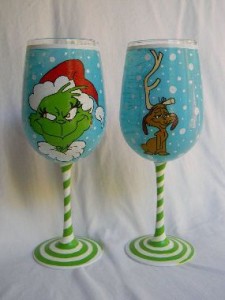
And that is my first objection to these objets d’art: they are typically not good wine glasses to begin with. No one is taking a Riedel Burgundy bowl that costs $25-$30 per stem, painting them to look like a dog or a cat or even putting a more pastoral scene on them. These tend to be cheap, fairly clunky glasses that do not favor the wine being served in them.
It is not my intention here to enter into the debate over whether a specific style of wine glass better suits a specific type of wine, but I do believe that good wine deserves a good drinking experience. And I know from my own experience and that of other wine geeks that a fine, somewhat delicate glass with a sizeable bowl enhances the wine drinking experience.
Moreover, wine lovers enjoy experiencing their wine with all of their senses. If you are even moderately serious about wine, you know that the look of the wine, its color, hue, clarity and opacity all convey important information about the wine you are about to drink. Assessing those characteristics requires one to peer through the wine, to see light coming though the wine, and of necessity the glass. That is next to impossible if the glass is covered in paint or even if it has patterns and colors that will influence the visual perception of the wine.
I do not mean to say that all wine drinking is serious business or is to be conducted as a wine tasting, dissecting each wine. Sometimes wine drinking is just that: drinking wine. But for those of us who make more of a study of wine, we do take enjoyment from fully appreciating our wines with all of our senses. That is better accomplished when you can actually see the wine you are drinking.
Wine Openers and Corkscrews
Wine openers are some of the most important tools of the wine geek. And it is here that the substitution of aesthetic considerations for the functional can be most problematic.
There are a number of different specialty openers that are designed to help remove old corks that may be breaking down. Sometimes, older corks or corks with certain flaws begin to lose their structural integrity and become too soft for a typical corkscrew. When you begin to exert upward pressure, the cork can disintegrate and the screw can simple pull out of the cork.
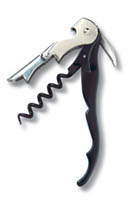
This is what you want. You can find them at your local wine store or online from dozens of different merchants. Starting at about $2, most wine lovers cannot have too many of these.
Openers like the Osso or the Durand have tongs that exert even, inward pressure on the cork as you begin to pull it, often keeping very old corks together until they are removed from the neck of the bottle. The Durand has tongs like the Osso but also has a screw that you wind into the cork. The two pieces then come together assuring the most even application of force across the entire cork, minimizing cork damage.
On the down side, these are very expensive openers. The Osso retails online starting for about $25, and the Durand is about $145. These are pricy, but these are fantastic gifts for the wine lovers in your life (I have asked Santa-Julie for the Durand this year!).
If that seems like a bit much for you (I am hoping I am worth it), the waiter’s wine key is one of the best openers on the market. Excellent models are available for about $6, but here is where it can get a little crazy. I have seen versions of the wine key for $60 or more, and here again, it is all about form and not function. Expensive versions of the wine key are often expensive because of the brand name, the material it is made from, or both. And what is really a problem is that many of the more expensive models are poorly designed, making them difficult to use effectively.
For the wine key to be effective, the short arm–the one that hooks onto the lip of the bottle, providing the fulcrum point–should be made of two pieces and hinged. The hinge allows you to angle the tool to actually gain purchase on the lip of the bottle. On many of the pricier models that arm is a single piece. Those openers are more difficult to use.
There is another popular opener in which the screw itself is attached at a 90 degree angle to the center of a straight piece of some material, perhaps whale bone, walrus tusk, or something more artistic. The cost often depends on what that material is, and yes, I have received several of these over the years. It is very difficult to open a bottle of wine with one of these. Once you drive the screw into the cork, the only force you can exert is by grasping the cross bar and pulling. You get no leverage or force multiplier of any kind, and that is hard.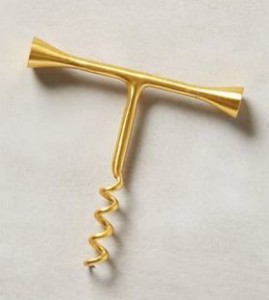
Finally, there is the rabbit, a very slick tool that has handles that grasp the neck of the bottle and a lever that forces a screw into the cork. Reversing the force on the lever extracts the cork from the bottle. I find it a very effective tool and easy to use once you have learned how to use it, but it is not intuitive. I have seen first time users flailing away, unsure how even to begin. It reminds me of the scene in the movie Pretty Woman in which Julia Roberts is at the opera, flipping the opera glasses over and over while repeating, “This one’s broken. Mine in broken.” The rabbit is also expensive, starting at around $40.
The Judgment
On the whole I realize that this article has been much more about what not to buy for your favorite wine lover than what gifts would be appropriate, but my motives are pure. I just thought that the madness had to stop. And with that, let me wish you all a very Merry Christmas and the happiest of holidays!
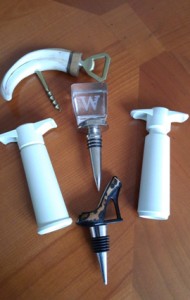
I try to think of art projects to use up all of the nonsense we have received over the years.